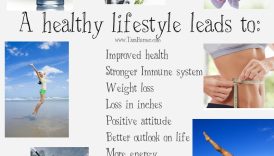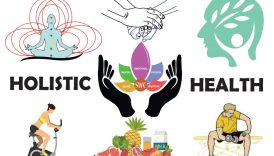Unlocking the Secrets of CDC-Approved Healthy Living

Overview of CDC-Approved Healthy Living
When it comes to maintaining a healthy lifestyle, the Centers for Disease Control and Prevention (CDC) provides a treasure trove of resources and guidelines. It’s fascinating how these recommendations can serve as a roadmap to health and wellness. Healthy living, as defined by the CDC, encompasses a balanced diet, regular physical activity, mental health strategies, and preventive health measures. For example, envision starting your day with a nutritious breakfast, perhaps oatmeal topped with fresh fruit and nuts. According to CDC guidelines, this simple yet effective choice aligns with a balanced diet. Moreover, it’s not just about what you eat; it’s also about making informed decisions throughout the day, such as opting for whole grain breads and colorful vegetables.
- Unlocking the Secrets of CDC-Approved Healthy Living
- Overview of CDC-Approved Healthy Living
- Importance of Following CDC Guidelines
- Nutrition Guidelines by CDC
- Balanced Diet Recommendations
- Understanding Nutrition Labels
- Exercise and Physical Activity
- CDC's Physical Activity Guidelines
- Incorporating Exercise into Daily Routine
- Mental Health and Well-being
- Strategies for Stress Management
- Importance of Getting Adequate Sleep
- Preventive Healthcare Measures
- Vaccination Recommendations by CDC
- Regular Health Screenings and Check-ups
Importance of Following CDC Guidelines
Following CDC guidelines is crucial for anyone seeking to improve their overall health. The recommendations are not just pie-in-the-sky ideas; they are based on extensive research and proven outcomes. Adhering to these principles can lead to:
- Enhanced immunity: A well-rounded diet and vaccination can support a robust immune system.
- Reduced healthcare costs: Preventing illnesses through healthy habits can save money on medical bills.
- Increased longevity: Healthy living can extend your life and enhance its quality.
For instance, a friend of mine implemented the CDC’s physical activity recommendations in their life by joining a community running group. They started running just 20 minutes a day, but now they participate in weekly races! This personal transformation not only improved their physical fitness but also contributed positively to their mental health. In summary, embracing the guidelines set forth by the CDC can pave the way for a fulfilling and vibrant life. By prioritizing a balanced diet, incorporating regular exercise, managing stress effectively, and participating in preventive healthcare, individuals can take significant strides toward becoming their healthiest selves. The journey toward healthy living is not only attainable; it’s a rewarding experience that can genuinely transform lives.
Nutrition Guidelines by CDC
Balanced Diet Recommendations
Continuing on the path to healthy living, one of the cornerstones emphasized by the CDC is the importance of a balanced diet. A balanced diet ensures that the body receives all the essential nutrients it needs to function optimally. It consists of various food groups, each providing unique health benefits:
- Fruits and Vegetables: Aim for a colorful plate! They are packed with vitamins, minerals, and antioxidants that support overall health.
- Whole Grains: Choose brown rice, whole wheat bread, and oats instead of refined grains. They offer more fiber and can keep you feeling full longer.
- Lean Proteins: Incorporate sources like chicken, fish, beans, and legumes. They are vital for building and repairing tissues.
- Dairy or Dairy Alternatives: Opt for low-fat or fat-free options to ensure you’re getting your calcium without excess fat.
For instance, I remember when I decided to revamp my eating habits. I started meal prepping a week’s worth of lunches filled with vibrant salads topped with grilled chicken and quinoa. This not only saved me time during busy weekdays but also made it easier to stick to a balanced diet.
Understanding Nutrition Labels
An essential aspect of making informed food choices is understanding nutrition labels. Labels provide valuable information that can guide you toward healthier selections at the grocery store. The CDC suggests focusing on several key components:
- Serving Size: Pay attention to the serving size to avoid consuming more calories than you intend. This is especially important for snacks!
- Calories: Keep track of the total calorie content and ensure it aligns with your dietary goals.
- Nutritional Content: Look for foods that are high in dietary fiber, vitamins, and minerals while low in added sugars, saturated fats, and sodium.
Nutrient Recommended Daily Value Fiber 25g Added Sugars Less than 10% of calories Sodium Less than 2300mg
Understanding how to read these labels can prevent misleading choices. For example, a seemingly healthy granola bar might have high sugar levels, masking its value as a nutritious snack. By learning to scrutinize labels, individuals can make smarter food choices that align with their health goals. By embracing these CDC nutrition guidelines, anyone can take meaningful steps toward a healthier lifestyle, ensuring that they nurture their bodies with the right balance of nutrients. The journey to better nutrition is not only fulfilling but incredibly empowering!
Exercise and Physical Activity
CDC’s Physical Activity Guidelines
As part of the transformative journey to healthy living, the CDC has established physical activity guidelines that serve as a framework for individuals to follow. The recommendations are straightforward and promote an active lifestyle that is crucial for both physical and mental health. According to the CDC, adults should aim for at least:
- 150 minutes of moderate-intensity aerobic activity each week, such as brisk walking, swimming, or cycling.
- Muscle-strengthening activities on two or more days a week, targeting major muscle groups like legs, arms, and core.
For example, I remember how participating in a local yoga class offered me both physical exercise and a calming mental escape after hectic workdays. This routine complemented my goal of reaching the CDC’s guidelines and helped me feel more balanced overall.
Incorporating Exercise into Daily Routine
Finding ways to seamlessly integrate exercise into one’s daily routine can be challenging; however, it is essential for maximizing the benefits of physical activity. Here are some practical strategies to get started:
- Set Realistic Goals: Start by setting achievable goals, such as walking for 20 minutes a day or trying a new workout class once a week.
- Plan Active Family Time: Instead of a movie night, consider organizing a family hike or bike ride. These activities can be an excellent way to bond while staying active.
- Utilize Short Breaks: Take advantage of those short breaks during work or study sessions. A quick 5-minute stretch, a few push-ups, or a brisk walk can add up throughout the day.
- Make Use of Technology: Fitness apps or wearable devices can be great motivators, reminding you to stay active and track your progress.
| Daily Activity Idea | Time Required |
|---|---|
| Quick home workout (10-15 mins) | 10-15 minutes |
| Walk during lunch break | 30 minutes |
| Family sports day | 1-2 hours |
Integrating movement into daily life not only helps meet the CDC’s recommendations but also enhances overall well-being. By choosing activities you enjoy and making them a consistent part of your routine, exercise can transform from a chore into a cherished part of life. Remember, it’s not about perfection; it’s about making gradual changes that lead to long-lasting habits. Embracing an active lifestyle will be one of the most rewarding choices you can make!
Mental Health and Well-being
Strategies for Stress Management
As we dive deeper into the concept of healthy living, it’s vital to address mental health and well-being, especially in today’s fast-paced world. The CDC highlights that effectively managing stress is crucial for maintaining a balanced life. Stress can impact both our physical and mental health, so adopting strategies to cope is essential. Here are some effective techniques:
- Practice Mindfulness and Meditation: Taking a few minutes each day for meditation can significantly reduce stress. Apps like Headspace or Insight Timer provide guided sessions that make it easy to get started.
- Engage in Physical Activity: As discussed previously, exercise can boost mood and lower stress levels. A simple walk in nature can do wonders for mental clarity.
- Stay Connected: Reach out to friends or family for support. Social connections can help alleviate feelings of loneliness and stress. I personally love catching up with a friend over coffee; sharing thoughts and experiences provides a refreshing perspective.
- Set Boundaries: Learn to say no. Overcommitting can lead to unnecessary stress, so it’s important to prioritize your well-being.
Importance of Getting Adequate Sleep
One of the key cornerstones of mental health is adequate sleep, yet it often takes a backseat in our busy lifestyles. The CDC emphasizes that adults should aim for 7 or more hours of quality sleep each night. Here’s why sleep is a game-changer for mental and physical well-being:
- Cognitive Function: A good night’s sleep enhances focus, decision-making, and problem-solving skills. Lack of sleep has a direct impact on productivity, making tasks feel daunting.
- Emotional Regulation: Sleep affects mood significantly. When well-rested, emotional responses are more balanced. On the other hand, sleep deprivation can increase anxiety and irritability.
- Physical Health: Quality sleep helps in the body’s repair process and plays a role in weight management and overall health.
To foster better sleep hygiene, try these tips:
| Sleep Hygiene Tip | Description |
|---|---|
| Create a Sleep-Promoting Environment | Keep your bedroom dark, quiet, and cool. |
| Limit Screen Time Before Bed | Reduce blue light exposure from devices an hour before sleeping. |
| Establish a Regular Sleep Schedule | Go to bed and wake up at the same time daily, even on weekends. |
Incorporating stress management strategies and prioritizing adequate sleep can lead to profound improvements in mental health. Remember that mental well-being is just as important as physical health; nurturing both will lead to a more holistic and fulfilling lifestyle. Through mindful practices and restful nights, anyone can pave the way for a happier, healthier life.
Preventive Healthcare Measures
Vaccination Recommendations by CDC
Continuing the discussion of holistic health, preventive healthcare measures play an integral role in maintaining overall well-being. One of the most effective ways to protect yourself from serious diseases is through vaccinations. The CDC provides clear guidelines on the importance and timing of immunizations for all age groups, emphasizing that staying up-to-date on vaccines can help prevent the spread of infectious diseases. For adults, recommended vaccinations may include:
- Influenza (Flu) Vaccine: Recommended yearly to reduce the risk of flu-related complications.
- Tdap (Tetanus, Diphtheria, Pertussis) Vaccine: A booster is advised every ten years.
- COVID-19 Vaccination: Staying updated with boosters as recommended.
I remember getting my flu shot every fall; while it may seem like a small step, it reassured me that I was doing my part to protect my health and those around me.
Regular Health Screenings and Check-ups
In addition to vaccinations, regular health screenings are vital preventive healthcare measures. Screenings can lead to early detection of conditions such as diabetes, high blood pressure, or certain types of cancer, which significantly increases the chances of successful treatment. According to CDC guidelines, key screenings may include:
- Blood Pressure Checks: At least once every two years for adults and more frequently if at risk.
- Cholesterol Tests: Recommended every 4 to 6 years for adults if at low risk.
- Cancer Screenings: This includes mammograms for breast cancer and colonoscopies for colorectal cancer, typically starting at age 45.
Creating a schedule for your health check-ups can alleviate the stress of remembering when to go. Consider setting reminders on your phone or keeping a dedicated health calendar.
| Screening Type | Recommended Frequency |
|---|---|
| Blood Pressure | Every 2 years |
| Cholesterol | Every 4 to 6 years |
| Blood Glucose | As per doctor’s advice, typically every 3 years |
| Cancer Screenings | Varies (consult your physician) |
Incorporating regular health check-ups into your routine, alongside vaccinations, is a proactive approach to your health. These preventive measures not only protect you but also contribute to achieving the broader public health goal of disease prevention. By prioritizing preventive healthcare, individuals can maintain their well-being and enjoy a high quality of life, allowing them to thrive in all aspects of their journey to health.





